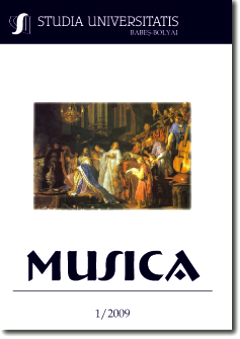EDUARD TERÉNYI’S STABAT MATER
Keywords:
Eduard Terényi, cross, suffering, glory, Virgin Mary, form, structure, variation, symmetry, folklore, central axisAbstract
Stabat Mater (1991) for two women soloists, women’s choir, percussion and organ by Eduard Terényi is a contemporary replica to the medieval poem, echoing some of the local literary and musical features, as cultural reference to a certain point in the local music history and to their geographical space. Exploring the stratum of the catholic melodies from the sixteenth - seventieth centuries in Transylvania, Eduard Terényi achieves the synthesis between Hungarian folk music and the European music. Therefore, the literary support of the first three parts of the work are religious folk lyrics in the Hungarian language, taken from Erdélyi Zsuzsanna’s collection Hegyet hágék, lőtőt lépék and the last three parts include Latin texts and melodies from Ion Caioni’s Cantionale Catholicum.
The musical structure of Stabat Mater is determined by the content of the ideas, the earthly moments of pain and further transfiguration in the celestial world. Each of Holy Mary’s two hypostases occupies three parts: her earthly state as Mater Dolorosa in the first three parts and the celestial one as Regina Coeli in te last three parts.
In the fourth part, the author has selected six strophes of Stabat Mater, intending to picture Christ’s crucifixion as the central axis of the work. Around this nucleus and in the light of the folk ethos, a framework is woven for the psychological drama, whose character is Holy Mary, Christ’s mother. The medieval poem not only contributes to the consistency of the dramatic plot, but it also represents the axis of multileveled mirror symmetry: the symmetrical unfolding of the semantics determines the symmetrical arrangement of the tonalities and their ethos, of musical macro-form and material.
References
* * *, Terényi, Eduard – in: The New Grove Dictionary of Music and Musicians, Edited by Stanley Sadie, London, 1992.
* * *, New American Standard Bible, Thomas Nelson, Publisher, Nashville-Camden-New York, 1977.
Coca, G., Ede Terényi – The retrospective of five decades of creation, in: Studia Universitatis Babeş-Bolyai, series Musica, nr. 1/2008, Cluj University Press, Cluj-Napoca, 2008.
Cosma, V. - Terényi, Eduard in: Muzicieni români, compozitori şi muzicologi (Romanian Musicians, composers and musicologist), Encyclopaedia, Muzica Publishing House, Bucharest, 1970
Hotoran, M. - The hymnologycal, theological and cultural pattern Christus Victor (Christ triumphant) and its relevance in Eduard Terényi’s musical creation, in: Studii de Imnologie (Hymnologycal Studies) vol. III, The Publishing House of the West University, Timişoara, 2006
Hotoran, M. – Patimile si moartea Domnului in viziunea componisticii secolului XX. Genul pasiunii (The dolorous passion and death of our Lord Jesus Christ in the works of the 20th century composers. The passio musical genre), Risoprint Publishing House, Cluj-Napoca, 2008
Hotoran, M. – Conceptul variaţional în creaţia pentru orgă a lui Ede Terényi (The variation concept in Ede Terényi’s organ music), Risoprint Publishing House, Cluj-Napoca, 2008
Pelikan, Jaroslav, Fecioara Maria de-a lungul secolelor. Locul ei în istoria culturii (Mary through the centuries. Her place in the History of Culture), Humanitas Publishing House, Bucharest, 1998
Terényi, E., The harmony of the modern music (1900-1950), Grafycolor Publishing Cluj-Napoca, 2006.
Downloads
Published
How to Cite
Issue
Section
License
Copyright (c) 2009 Studia Universitatis Babeș-Bolyai Musica

This work is licensed under a Creative Commons Attribution-NonCommercial-NoDerivatives 4.0 International License.



